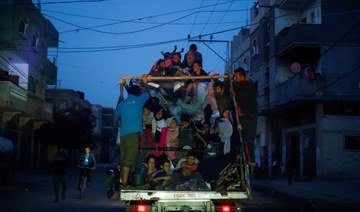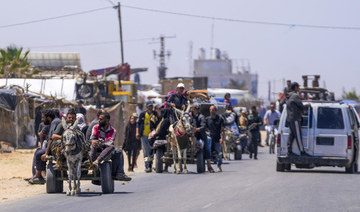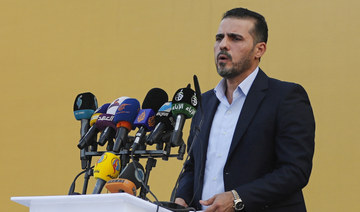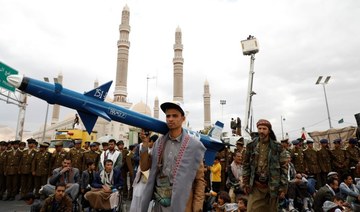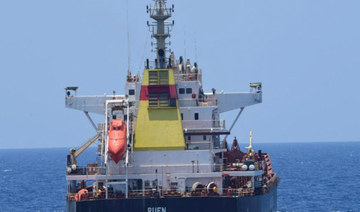BEIRUT: Daesh militants staged a surprise attack early Tuesday at a crossing frequently used by Iraqi and Syrian civilians seeking safety in northeastern Syria, killing at least 37 people, mostly civilians, Kurdish officials and activists said.
The militants struck before dawn after sneaking into the village of Rajm Sleibi, located along a front line that separates the Kurdish-controlled Hassakeh province from Daesh-held areas further south. Some militants reportedly blew themselves up at a Kurdish checkpoint while others attacked sleeping civilians in a nearby temporary camp sheltering hundreds of displaced people who fled IS-controlled territory.
The International Rescue Committee said thousands of people from the Iraqi city of Mosul have traveled west to the Sleibi crossing since October, often via smugglers. In a statement, it said several children were among the dead and wounded.
“It was three in the morning when Daesh came and started to shoot at people,” said Abdulah Khalef Hamid, an Iraqi refugee from Mosul, who said his mother-in-law was killed in Tuesday’s attack. “I was wounded and they thought I was dead so they left me. We were around 200 families, they left at sunrise,” he added.
Redur Khalil, a spokesman for the main Kurdish fighting force in Syria, said the attack started with an early morning assault by Daesh militants on a checkpoint in Sleibi belonging to the Syrian Democratic Forces, a US-backed and Kurdish-dominated force that fights Daesh.
The militants then “committed a massacre” against civilians as they sought to enter SDF-controlled territory, Khalil said.
He told The Associated Press the attack came a few hours after IS suicide bombers dressed in civilian clothes sneaked into the town of Shaddadeh and attacked SDF forces, triggering clashes that were ongoing.
Survivors from the attack on the camp said the militants arrived in four cars before shooting several people and kidnapping others.
“They were shouting ‘You are infidels and you are going toward the infidels,’” said Fatima, a displaced Syrian woman who asked that her last name not be used, fearing retribution. “They shot at the checkpoint and at the civilians there, and they dragged the youngsters and put them in the cars and drove them away,” she said.
Issam Amin, a media activist in Hassakeh, said the victims arriving at the city’s hospitals had stabbing and gunshot wounds.
The Britain-based Syrian Observatory for Human Rights, which tracks the Syrian conflict through activists on the ground, said Tuesday’s attack included suicide bombers and heavy clashes with the SDF. The Observatory put the death toll at 38, including 23 civilians, many of them Iraqi. Hawar, a news agency for the semi-autonomous Kurdish areas in Syria, put the death toll at 37.
The Daesh group is under attack by an array of forces in Syria and Iraq.
In Syria, the SDF is now fighting to recapture the town of Tabqa, an important militant stronghold located about 40 kilometers (25 miles) southeast of the IS group’s de facto capital, Raqqa. Kurdish officials said Kurdish-led opposition fighters have pushed the extremists almost completely out of Tabqa and were cleaning up the town. They said Daesh continues to hold the nearby dam on the Euphrates River.
In Iraq, the extremist group is fighting for survival against Iraqi forces and their allies in the last neighborhoods it still holds in the western part of Mosul, Iraq’s second largest city.
Daesh claimed responsibility for Tuesday’s attacks through its Aamaq media arm, saying its fighters attacked four Kurdish positions in the southern countryside of Hassakeh province.
Rajm Sleibi lies about 30 kilometers (18 miles) south of the town of Al-Hol, which houses a large refugee camp for civilians displaced from Syria and Iraq. A Kurdish activist said it is the entry point to Hassakeh for Syrians civilians fleeing the eastern cities of Deir el-Zour and Raqqa, and those fleeing from Mosul and elsewhere in Iraq. The civilians spend about two weeks in Rajm Sleibi while they get security clearance from Kurdish authorities, and are then taken to Al-Hol.
The activist spoke on condition of anonymity, fearing for his safety.
The camp is within the zone of influence of the SDF but not directly protected by its forces.
Elsewhere in Syria, opposition activists said Daesh killed 10 of its own after accusing them of selling weapons to arms traders. The activists said the killings took place in the Mayadeen area in eastern Syria, near the Iraqi border.
The Observatory and Omar Abu Laila, a Europe-based activist with contacts in the area, said the men were all Iraqis and were shot dead Monday in a main street in front of dozens of onlookers.
___
Associated Press writers Philip Issa and Bassem Mroue in Beirut, and Albert Aji in Damascus, Syria, contributed to this report.
Daesh attack on displaced in Syria kills nearly 40
Daesh attack on displaced in Syria kills nearly 40
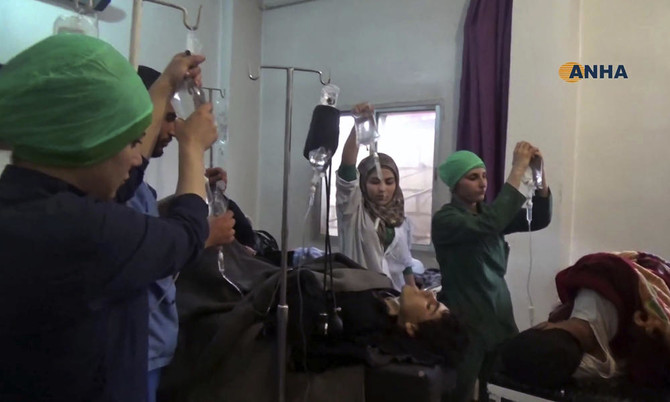
Hamas releases video of Israeli-British hostage held in Gaza

- The video posted on the group’s Telegram channel and showing the hostage speaking under duress
GAZA: Hamas’s armed wing, the Ezzedine Al-Qassam Brigades, on Saturday released a video of a man held hostage in Gaza by Palestinian militants and seen alive in the footage.
The captive, identified by the Hostages and Missing Families Forum campaign group as Nadav Popplewell, is seen speaking in the 11-second clip, which is superimposed with text in Arabic and Hebrew that reads: “Time is running out. Your government is lying.”
In the video the hostage, who is also a British national, has a black eye and is seen speaking under duress.
He showed no other visible signs of injuries.
Wearing a white T-shirt, he introduces himself as 51-year-old Popplewell, from kibbutz Nirim in southern Israel.
Popplewell was kidnapped from his home during Hamas’s October 7 attack along with his mother, Hanna Peri, who was released during a one-week truce in November — the only pause so far in more than seven months of war.
Popplewell’s older brother was killed in the attack.
The video posted Saturday on the Telegram channel of Hamas’s armed wing was the third time in less than a month that the group releases footage of captives held in Gaza.
On April 27 Hamas released a video showing two hostages alive — Keith Siegel and Omri Miran.
Three days earlier it broadcast another video showing hostage Hersh Goldberg-Polin alive.
The videos come amid growing domestic pressure on the Israeli government to secure the release of the remaining hostages.
“Every sign of life received from the hostages held by Hamas is another cry of distress to the Israeli government and its leaders,” the families’ group said in its statement on Saturday.
“We don’t have a moment to spare! You must strive to implement a deal that will bring them all back today.”
Prime Minister Benjamin Netanyahu and his government are under immense pressure to strike a deal with Hamas, but the two warring sides have so far failed despite repeated rounds of indirect negotiations.
Some 250 people were abducted to the Gaza Strip on October 7 when Hamas militants attacked southern Israel.
Israeli officials say 128 of them are still held captive in the Palestinian territory, including 36 who are dead.
The attack resulted in the deaths of more than 1,170 people, mostly civilians, according to an AFP tally based on official Israeli figures.
In Israel’s retaliatory military campaign in Gaza, at least 34,971 people have been killed so far, most of them women and children, according the Hamas-run territory’s health ministry.
Israel strikes Gaza as more Rafah evacuations ordered

- Fighting is escalating across the enclave with heavy clashes between Israeli troops and Palestinian militants
- Israel’s move into Rafah has so far been short of the full-scale invasion that it has planned
RAFAH, Gaza Strip: Israeli strikes on Saturday hit parts of Gaza including Rafah where Israel expanded an evacuation order and the UN warned of “epic” disaster if an outright invasion of the crowded city occurs.
AFP journalists, medics and witnesses reported strikes from the south to the north of the coastal territory, where the UN says aid is blocked after Israeli troops defied international opposition and entered eastern Rafah this week, effectively shutting two crossings.
At least 21 people were killed during strikes in central Gaza and taken to Al-Aqsa Martyrs Hospital in Deir Al-Balah city, a hospital statement said.
Bodies covered in white lay on the ground in a courtyard of the facility. A man in a baseball cap leaned over one body bag, clasping a dust-covered hand that protruded.
The feet of another corpse poked from under a blanket bearing the picture of a large teddy bear.
In Rafah, witnesses reported intense air strikes near the crossing with Egypt, and AFP images showed smoke rising over the city.
Other strikes occurred in north Gaza, they said.
Israeli troops on Tuesday seized and closed the Palestinian side of the Rafah crossing — through which all fuel passes into Gaza — after ordering residents of eastern Rafah to evacuate.
Israel’s military said it went into eastern Rafah to pursue Palestinian militants.
Fighting continued on the Gazan side of the Rafah crossing, the military reported on Friday, before on Saturday expanding its evacuation order to more areas of Rafah’s east.
Evacuation orders
The new order, posted on social media platform X by military spokesman Avichay Adraee, said the designated areas had “witnessed Hamas terrorist activities in recent days and weeks.”
The war began with Hamas’s unprecedented October 7 attack on Israel, which resulted in the deaths of more than 1,170 people, mostly civilians, according to an AFP tally of Israeli official figures.
During their attack, militants also seized hostages. Israel estimates 128 of them remain in Gaza including 36 whom the military says are dead.
Israel’s retaliatory offensive has killed at least 34,971 people in Gaza, mostly women and children, according to the Hamas-run territory’s health ministry.
A US State Department report on Friday said Israel likely violated norms on international law in its use of weapons from the United States but it did not find enough evidence to block shipments.
The State Department submitted its report two days after President Joe Biden publicly threatened to withhold certain bombs and artillery shells if Israel goes ahead with an all-out assault on Rafah, where the United Nations said 1.4 million had been sheltering.
Israeli Prime Minister Benjamin Netanyahu has pledged to “eliminate” Hamas battalions in Rafah and achieve “total victory,” after the army in January said it had dismantled the Hamas command structure in northern Gaza.
But on Saturday Adraee said Hamas “is trying to rebuild” there, and ordered evacuations from the north’s Jabalia and Beit Lahia areas.
After rising criticism from Washington over the civilian impact of Israel’s war against Hamas, the threat to withhold weapons was the first time Biden raised the ultimate US leverage over Israel — its military aid which totals $3 billion annually.
UN Secretary-General Antonio Guterres said Friday that Gaza risked an “epic humanitarian disaster” if Israel launched a full-scale ground operation in Rafah.
While the army said it reopened Kerem Shalom crossing near Rafah on Wednesday, aid agencies cautioned that getting assistance through the militarised area remained extremely difficult.
Aid in limbo
A UN report late Friday cited Martin Griffiths, the UN’s aid chief, as saying closure of the crossings “means no aid.”
Israel has said its Erez crossing into northern Gaza remains open.
The State Department report said it was “reasonable to assess” that Israel has used American weapons in ways inconsistent with standards on humanitarian rights but that the United States could not reach “conclusive findings.”
The report does not affect Biden’s threat to withhold some weapons.
On Friday the White House said it did not yet see a “major ground operation” in Rafah but was watching the situation “with concern.”
Biden’s administration had already paused delivery of 3,500 bombs as Israel appeared ready to attack Rafah.
More than 100,000 people fled the city after the initial evacuation order, the United Nations said on Friday.
Israel on Saturday gave a figure of 300,000, as more Rafah residents piled water tanks, mattresses and other belongings onto vehicles and prepared to flee again.
Malek Al-Zaza, with a trim grey beard, said he has been displaced three times now during the war and found “no food” and “no water” in central Gaza’s Nuseirat camp where he has returned.
“We only have God looking out for us,” he said.
Humanitarian crisis
Israel said it had delivered 200,000 liters of fuel to Gaza on Friday through Kerem Shalom — the amount the United Nations says is needed every day to keep aid trucks moving and hospital generators working.
Reiterating his calls for a ceasefire, Guterres said: “We are actively engaged with all involved for the resumption of the entry of life-saving supplies — including desperately needed fuel — through Rafah and Kerem Shalom crossings.”
The evacuation order on Saturday told residents to go to the “humanitarian zone” of Al-Mawasi, on the coast northwest of Rafah.
That area has “extremely limited access to clean drinking water, latrines, et cetera,” said Sylvain Groulx, Doctors Without Borders (MSF) emergency coordinator in Gaza.
The army late Friday said rocket fire from Gaza wounded an Israeli civilian in the southern city of Beersheba. It was the first time since December that the city had come under Palestinian rocket attack.
In New York, the UN General Assembly voted overwhelmingly to grant the Palestinians additional rights in the global body and backed their drive for full membership.
Palestinian ambassador to the UN Riyad Mansour said the vote was historic, but Israeli Foreign Minister Israel Katz said the move told Hamas that “violence pays off.”
Hamas says Gaza ceasefire efforts are back at square one

- Israel has killed more than 34,700 Palestinians, according to Gaza’s Health Ministry
CAIRO: The Palestinian militant group Hamas said on Friday that efforts to find a Gaza Strip truce deal were back at square one after Israel effectively spurned a plan from international mediators, and the White House said it was trying to keep the sides engaged “if only virtually.”
Hamas said in a statement it would consult with other Palestinian factions on its strategy for talks to halt seven months of war triggered by its deadly Oct. 7 attack on Israel.
Hours earlier, the United Nations warned that aid for Gaza could grind to a halt in days after Israel seized control this week of the Rafah crossing between Gaza and Egypt, a vital route for supplies to the devastated Palestinian enclave.
Despite heavy US pressure, Israel has said it will proceed with an assault on the southern Gaza city of Rafah, where more than 1 million displaced people have sought refuge and Israeli forces say Hamas militants are dug in.
Israeli tanks captured the main road dividing the eastern and western sections of Rafah, effectively encircling the eastern part of the city in an assault that has caused Washington to hold up delivery of some military aid.
The White House said that it was watching “with concern,” but the Israeli operations appeared to be localized around the shuttered Rafah crossing and did not reflect a large-scale invasion.
“Once again, we urge the Israelis to open up that crossing to humanitarian assistance immediately,” said White House national security spokesman John Kirby.
Israel’s plan for an all-out assault on Rafah has ignited one of the biggest rifts in generations with its main ally. Washington held up a weapons shipment over fears of massive civilian casualties.
In a report to Congress, President Joe Biden’s administration on Friday said it was reasonable to assess that Israel had used US arms in instances “inconsistent” with international humanitarian law.
However, the administration said it still found credible and reliable Israel’s assurances that it will use US weapons in accordance with international humanitarian law.
Indirect diplomacy has failed to end a war that health authorities in Hamas-run Gaza say has killed almost 35,000 people since the Oct. 7 attack. Some 1,200 people were killed in Israel and 253 taken hostage on Oct. 7, according to Israeli tallies.
Ceasefire talks in Cairo broke up on Thursday with no agreement.
Hamas had said it agreed at the start of the week to a proposal by Qatari and Egyptian mediators that had previously been accepted by Israel. Israel said the Hamas proposal contained elements it cannot accept.
“Israel’s rejection of the mediators’ proposal through the amendments it made returned things to the first square,” Hamas said in Friday’s statement.
“In the light of (Israel Prime Minister Benjamin) Netanyahu’s behavior and rejection of the mediators’ document and the attack on Rafah and the occupation of the crossing, the leadership of the movement will hold consultations with the brotherly leaders of the Palestinian factions to review our negotiation strategy.”
“Hamas did not suspend nor withdraw from the negotiations; the occupation (Israelis) turned against the mediators’ proposal,” a senior Hamas official, Khalil Al-Hayya, said in comments to Al Araby TV published by Hamas.
Kirby said the end of the talks — which CIA Director William Burns was helping mediate — was “deeply regrettable,” but the US believed the differences were surmountable.
“We are working hard to keep both sides engaged in continuing the discussion, if only virtually,” he said.
EXPLOSIONS AND GUNFIRE
Residents described almost constant explosions and gunfire east and northeast of Rafah on Friday, with intense fighting between Israeli forces and militants from Hamas and Islamic Jihad.
Hamas said it ambushed Israeli tanks near a mosque in the east of the city, a sign the Israelis had penetrated several kilometers from the east to the outskirts of the built-up area.
Israel has ordered civilians out of the eastern part of Rafah, forcing tens of thousands of people to seek shelter outside the city, previously the last refuge of more than a million who fled other parts of the enclave during the war.
Israel says it cannot win the war without assaulting Rafah to root out thousands of Hamas fighters it believes are sheltering there. Hamas says it will fight to defend it.
Supplies were already running short and aid operations could halt within days as fuel and food stocks get used up, UN aid agencies said.
“For five days, no fuel and virtually no humanitarian aid entered the Gaza Strip, and we are scraping the bottom of the barrel,” said the UNICEF Senior Emergency Coordinator in the Gaza Strip, Hamish Young.
Aid agencies say the battle has threatened hundreds of thousands of displaced civilians.
“It is not safe, all of Rafah isn’t safe, as tank shells landed everywhere since yesterday,” Abu Hassan, 50, a resident of Tel Al-Sultan west of Rafah told Reuters via a chat app.
“I am trying to leave but I can’t afford 2,000 shekels ($540) to buy a tent for my family,” he said. “There is an increased movement of people out of Rafah even from the western areas, though they were not designated as red zones by the occupation.”
Israeli tanks have sealed off eastern Rafah from the south, capturing and shutting the only crossing between the enclave and Egypt. An advance on Friday to the Salahuddin road that bisects the Gaza Strip completed the encirclement of the “red zone” where they have ordered residents out.
The Israeli military said its forces in eastern Rafah had located several tunnel shafts, and troops backed by an air strike fought at close quarters with groups of Hamas fighters, killing several.
It said Israeli jets had hit several sites from which rockets and mortar bombs had been fired toward Israel.
The UN General Assembly overwhelmingly backed a Palestinian bid to become a full UN member by recognizing it as qualified to join and recommending the UN Security Council “reconsider the matter favorably.”
Iranians vote in parliamentary runoff election

- Politicians calling for change in the country’s government, known broadly as reformists, were generally barred from running in the election
TEHRAN: Iranians voted on Friday in a runoff election for the remaining seats in the country’s parliament after hard-line politicians dominated March balloting.
People in 22 constituencies across the country will elect 45 representatives from a pool of 90 candidates, 15 of whom are considered moderate.
In the capital, Tehran, 16 representatives will be chosen from 32 candidates, all hard-liners.
Final results are expected on Monday, though counts in smaller constituencies are likely before that.
Iran’s parliament plays a secondary role in governing the country.
Supreme Leader Ali Khamenei has the final say in all important state matters.
State TV showed Khamenei voting on Friday immediately after the polls opened.
He urged people to vote and said the runoff election was as important as the main one.
In the March election, hard-liners won 200 out of 245 seats, with more moderate candidates taking the other 45. A total of 25 million ballots were cast, for a turnout of just under 41 percent.
The previous lowest turnout was 42 percent in the 2020 parliamentary election.
Politicians calling for change in the country’s government, known broadly as reformists, were generally barred from running in the election.
Those calling for radical reforms or for abandoning Iran’s theocratic system were also banned or did not bother to register as candidates.
Suspected pirate attack in Gulf of Aden raises concerns about growing Somali piracy

- Somali piracy in the region at the time cost the world’s economy some $7 billion — with $160 million paid out in ransoms, according to the Oceans Beyond Piracy monitoring group
DUBAI: A European naval force detained six suspected pirates on Friday after they opened fire on an oil tanker traveling through the Gulf of Aden, officials said, likely part of a growing number of piracy attacks emanating from Somalia.
The attack on the Marshall Islands-flagged Chrystal Arctic comes as Houthis have also been attacking ships traveling through the crucial waterway, the Red Sea, and the Bab Al-Mandeb Strait connecting them.
The assaults have slowed commercial traffic through the key maritime route onward to the Suez Canal and the Mediterranean Sea.
The pirates shot at the tanker from a small ship “carrying weapons and ladders,” according to the British military’s UK Maritime Trade Operations Center, which oversees Mideast shipping routes.
The pirates opened fire first at the Chrystal Arctic, whose armed onboard security team returned fire at them, the UKMTO said.
BACKGROUND
Maritime sources say pirates may be encouraged by a relaxation of security or may be taking advantage of the chaos caused by attacks on shipping by the Houthis.
The pirates then abandoned their attempt to take the tanker, which continued on its way with all its crew safe, the UKMTO said.
Hours later, the EU naval force in the region known as Operation Atalanta said a frigate operating in the region detained six suspected pirates.
The frigate seized the pirates, given “the unsafe condition of their skiff” and said that some had “injuries of varied severity.”
It was not immediately clear if those injured suffered gunshot wounds from the exchange of fire with the Chrystal Arctic.
The EU force declined to elaborate “due to the security of the operations.”
Once-rampant piracy off the Somali coast diminished after a peak in 2011. That year, there were 237 reported attacks in waters off Somalia.
Somali piracy in the region at the time cost the world’s economy some $7 billion — with $160 million paid out in ransoms, according to the Oceans Beyond Piracy monitoring group.
Increased naval patrols, a strengthening central government in Mogadishu, Somalia’s capital, and other efforts saw the piracy beaten back.
However, concerns about new attacks have grown in recent months.
According to the International Maritime Bureau, five incidents were reported off Somalia in the first quarter of 2024.
“These incidents were attributed to Somali pirates who demonstrate mounting capabilities, targeting vessels at great distances from the Somali coast,” the bureau warned in April.
It added that there had been “several reported hijacked dhows and fishing vessels, which are ideal mother ships to launch attacks at distances from the Somali coastline.”
In March, the Indian navy detained dozens of pirates who seized a bulk carrier and took its 17 crew hostage.
In April, pirates release 23 crew members of the Bangladesh-flagged cargo carrier MV Abdullah after seizing the vessel.
The terms of the release are not immediately known.
These attacks come as the Houthi campaign has targeted shipping since November as part of their pressure campaign to stop the Israel-Hamas war raging in the Gaza Strip.



